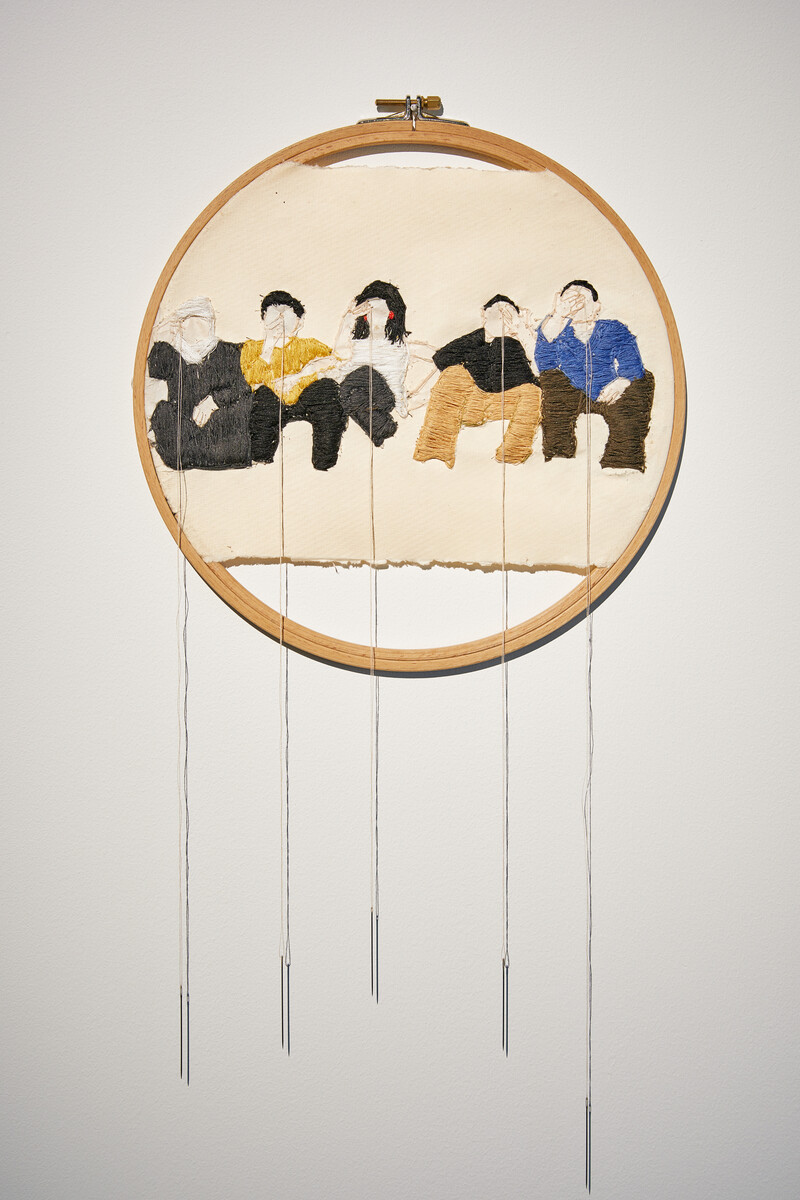The Electronic Intifada 10 February 2017

Majd Masri, “Haphazard Synchronizations,” 2016 (Photograph by Andy Stagg, courtesy of The Mosaic Rooms)
Pattern Recognition, The Mosaic Rooms, London, through 18 March
The work of young Palestinian artists grappling with the past is on display at London’s Mosaic Rooms.
The featured artists are selected from the Palestinian cultural organization A. M. Qattan Foundation’s shortlist for the biennial Young Artist of the Year Award.
This new generation of painters, photographers and sound and installation artists have a great deal of history to digest. Themes of fragility and endurance are wrestled in each of the works of the collection.
“Mnemosyne” by Inas Halabi – who took first prize in the foundation’s young artist contest – is a video work bookended with three frames of unfinished embroidery.
The video shows different members of Halabi’s family telling their version of the story of a small scar on her grandfather’s forehead. On the walls beside the video are embroidery hoops encircling stitched images of key themes that come out of the rememberings.
Tenuous and vulnerable

Inas Halabi, “Mnemosyne,” stitched work, 2016 (Photograph by Andy Stagg, courtesy of The Mosaic Rooms)
Each aunt, uncle and grandparent folds different details into the story of the patriarch, whose injury – sometimes on the right side of his forehead, sometimes on the left, depending on who is telling the story – was incurred by an Israeli-fired bullet sometime around 1948.
One family member is sure it happened as the young man was being driven out of his homeland during the ethnic cleansing of Palestine. Another declares the wound was sustained as he snuck back into the country from Lebanon after the State of Israel was declared. A third recalls the chickens a fellow refugee was carrying as the grandfather saw the woman shot.
The panels of embroidery – showing a silhouette of the grandfather, the family he would later father, a red chicken – are tenuously stitched on tracing paper.
The needle used to guide the gold thread into the shape of the patriarch, remembered now only through the family that survives him, dangles down from the embroidery hoop, as if the portrait is unfinished. The object is vulnerable: a single jerk of the thread would tear the paper, obliterating its subject.
The grandfather, immortalized by family myth, is at once as solid as gold and as fragile as dry tracing paper.
Refracted time
Majd Masri’s “Haphazard Synchronizations” series refracts time by reproducing the history of Palestinian portraiture in a set of six canvases.
The works variously imitate the vibrant portraits of Sliman Mansour and Nabil Anani, the stark black-and-white drawings of the assassinated political cartoonist Naji al-Ali, as well as Laila Shawa’s armaments installations.
Each canvas depicts the same woman holding a rifle and a sprig of jasmine, the pose reminiscent of Leila Khaled’s iconic photograph taken after her successful 1969 airplane hijacking.
Whatever and whoever the woman of the six canvasses might have been seems lost to time. The repetition turns her into a powerful myth while destroying the actual woman she may have been.

Somar Sallam, “Disillusioned Construction,” 2016 (Image courtesy of The Mosaic Rooms)
In Somar Sallam’s “Disillusioned Construction,” the fabric of memory is literally unraveled as the squares of a knitted blanket, in the colors of the Syrian flag under which Sallam grew up as a refugee, are slowly pulled apart.
Video shows the naked body of a sleeping woman slowly exposed as the threads of the blanket come undone. Heaps of yarn – the unraveled blanket – and the wooden sticks used to knit it sit underneath the video display.
Sallam’s story is both a warning and hope for this generation of artists: that without a careful hand, the thread holding together the image of a grandfather, and the essence holding together the myth of the Palestinian woman, might both come undone.
Each of the three artists’ works are, in their own way, the Mnemosyne alluded to in Halabi’s project. A Greek mythological figure, Mnemosyne is the personification of memory who, over the course of nine nights, bore Zeus the nine muses.
The source of all knowledge that comes from the nine arts, the muses form that invisible connection with the past, its recollection, and the way it is preserved for those who would come after.
Nora Parr is Lecturer of English and Comparative Literature at King’s College London.





